1. Overview
Takeo Arishima (有島 武郎Arishima TakeoJapanese, March 4, 1878 - June 9, 1923) was a prominent Japanese novelist, short-story writer, and essayist who was active during the late Meiji period and Taishō period. Born into a wealthy family, Arishima's life and literary career were profoundly shaped by his extensive education in Japan and abroad, particularly his studies in the United States, where he developed a strong critique of Christianity and embraced socialism. He was a central figure in the Shirakaba (White Birch) literary group, known for its humanistic and individualistic ideals.
Arishima's works are characterized by their emotionally intense and humanistic style, often reflecting a deep social critique. His major novels, such as The Descendents of Cain and A Certain Woman, explore themes of human suffering, societal hypocrisy, and the struggle for individual freedom against oppressive norms. A staunch advocate of socialist philosophy, Arishima famously renounced ownership of his family's tenant farm in Hokkaido, a practical application of his beliefs. His life ended tragically in a double suicide with his lover, Akiko Hatano, an event that deeply shocked Japanese society. His extensive diaries, spanning over twenty volumes, provide an intimate record of his thoughts and struggles, solidifying his legacy not only as a novelist but also as a philosopher and social critic who challenged the conventions of his time.
2. Early Life and Education
Takeo Arishima's early life was marked by a privileged upbringing and a diverse educational journey that laid the foundation for his later intellectual and literary pursuits.
2.1. Birth and Family Background
Arishima Takeo was born in Koishikawa, Tokyo (present-day Bunkyō-ku), Japan, on March 4, 1878. He was the eldest son of Arishima Take, an influential figure who was a former samurai official from the Satsuma Domain, an official in the Ministry of Finance, and a successful businessman. His mother was Sachiko, and his grandfather, Uhei, was also a local samurai. When Takeo was four years old, his family relocated to Yokohama after his father was appointed head of the Yokohama Customs. Following his father's educational philosophy, Takeo lived with an American family during this period and attended Yokohama Eiwa Girls' School (now Aoyama Gakuin Yokohama Eiwa Elementary School), an experience that later inspired his children's story, A Bunch of Grapes.
2.2. Education
At the age of 10, Arishima entered the preparatory school of the prestigious Gakushuin peer's school, where he lived as a boarder. He graduated from Gakushuin's secondary school at 19. Subsequently, he enrolled in Sapporo Agricultural College (the present-day Faculty of Agriculture at Hokkaido University), aspiring to become an agricultural scholar. During his time at the college, he attempted suicide alongside his friend Kokichi Morimoto. Arishima was deeply influenced by Uchimura Kanzō, a prominent Christian evangelist, and converted to Christianity in 1901. Morimoto later became known for establishing several women's schools across Japan.
3. Studies Abroad and Intellectual Development
Arishima's time abroad, particularly in the United States, proved to be a pivotal period in his intellectual development, shaping his worldview and literary inclinations.
3.1. Sojourn in the United States
After graduating from Sapporo Agricultural College and completing a mandatory brief stint in the Imperial Japanese Army, Arishima took English lessons from Mary Elkinton Nitobe, the wife of Inazo Nitobe. In July 1903, he secured a position as a foreign correspondent in the United States for the Mainichi Shimbun newspaper. In the United States, he pursued further studies, first enrolling at Haverford College, a Quaker institution located outside Philadelphia, and later attending Harvard University for about a year, where he studied history and economics. Following his graduation, he briefly worked in an insane asylum operated by the Quaker sect. He meticulously documented his experiences and observations from his journey to America in his comprehensive diary.
During his stay in America, Arishima's intellectual and spiritual views underwent significant transformation. He became increasingly critical of Christianity, despite his earlier conversion, and developed a strong attraction to socialism. He was profoundly influenced by the works of prominent Western writers and thinkers, including Walt Whitman, Henrik Ibsen, and Peter Kropotkin, as well as Western philosophers such as Henri Bergson and Friedrich Nietzsche. His experiences in America, and a subsequent year in Europe, profoundly impacted his writing style and shaped his outlook on the world, leading to a profound sense of alienation from conventional Japanese society upon his return.
3.2. European Sojourn and Return to Japan
After his studies in the United States, Arishima spent a brief period in Europe before returning to Japan on April 11, 1907. During this time, his doubts about Christianity solidified, leading him to abandon his Christian faith. Upon his return, he briefly re-entered military service as a reserve officer cadet. In 1909, he began teaching English and ethics at his alma mater, which had by then become the Tohoku Imperial University Agricultural College (later Hokkaido University). In 1908, he co-founded the "Kuroyuri-kai" (Black Lily Society) art club at the university, which continues to exist today. Notably, Arishima secretly provided funds to the anarchist Ōsugi Sakae for his attempt to travel abroad to participate in the International Anarchist Congress in Berlin, stating that he felt it was a waste to keep such a great individual confined to Japan and that Ōsugi should see the world.
4. Literary Career
Arishima Takeo's literary career was marked by his significant contributions to the Shirakaba group and his distinctive style, which explored profound humanistic and social themes.
4.1. The Shirakaba Group
Through his younger brother, Ikuma Arishima, Takeo became acquainted with other prominent authors who had also graduated from Gakushuin, including Naoya Shiga and Saneatsu Mushanokōji. Together, Arishima and these writers formed a literary group named after their influential literary magazine, {{lang|ja|白樺|Shirakaba|White Birch}}, which was first published in 1911. Arishima quickly emerged as one of the central figures of the Shirakaba group, contributing numerous novels and literary criticisms.
4.2. Major Works
Arishima first gained widespread recognition in 1917 with his novel {{lang|ja|カインの末裔|Kain no Matsuei|The Descendents of Cain}}. This work powerfully depicts God's curse on both humanity and nature, seen through the eyes of a self-destructive tenant farmer. In 1919, he published his most renowned work, A Certain Woman (或る女Aru OnnaJapanese), a moral and psychological melodrama that portrays the struggles of a strong-willed woman against a hypocritical, male-dominated society.
Other notable works by Arishima include:
- かんかん虫Kankan MushiJapanese
- お末の死Osue no ShiJapanese (The Death of Osue)
- {{lang|ja|生れ出づる悩み|Umare Izuru Nayami|The Agony of Coming Into the World}}
- {{lang|ja|迷路|Meiro|Labyrinth}}
- {{lang|ja|骨|Kotsue|Bone}}
- {{lang|ja|酒狂|Shukyo|Alcohol Madness}}
- {{lang|ja|文化の末路|Bunka no Matsuro|The End of Culture}}
- {{lang|ja|運命の訴へ|Unmei no Uttae|The Appeal of Fate}}
- {{lang|ja|星座|Seiza|Constellation}}
- {{lang|ja|小さき者へ|Chiisaki Mono e|To the Little Ones}}
- {{lang|ja|実験室|Jikkenshitsu|Laboratory}}
- ドモ又の死Domo Mata no ShiJapanese (play)
- Essays such as Love is a Ruthless Plunderer (惜しみなく愛は奪ふOshimimaku Ai wa UbauJapanese), {{lang|ja|宣言一つ|Sengen Hitotsu|A Declaration}}, and {{lang|ja|二つの道|Futatsu no Michi|Two Paths}}.
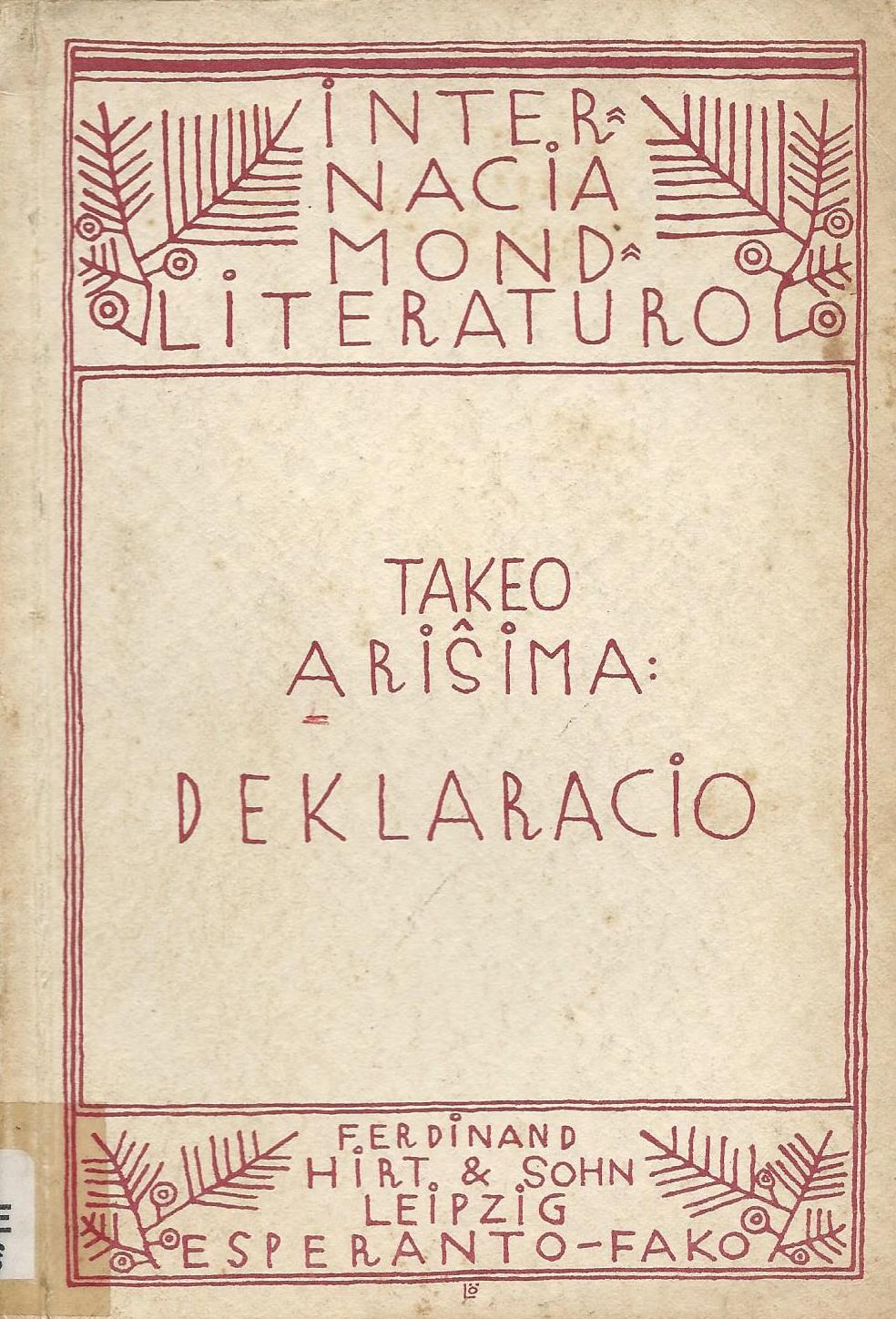
- Children's stories like A Bunch of Grapes (一房の葡萄Hitofusa no BudōJapanese) and {{lang|ja|溺れかけた兄妹|Oborekaketa Kyodai|The Drowning Siblings}}.
Arishima also penned the lyrics for the Sapporo Agricultural College school song, "Eternal Happiness" (永遠の幸Eien no SachiJapanese), which later became the official school song for Hokkaido University.
4.3. Literary Style and Themes
Arishima's literary style was critically acclaimed for its emotional intensity and humanistic depth. His works frequently employed ideas drawn from the Bible, the writings of Leo Tolstoy, and anarchic socialism. While his style garnered praise, the profound and often challenging themes and characters in his works did not always resonate with a broad contemporary Japanese readership. His narratives often reflected a strong social critique, challenging the hypocrisy and patriarchal structures he observed in Japanese society.
5. Thought and Social Philosophy
Takeo Arishima's intellectual journey led him to embrace humanistic and socialist ideals, which profoundly shaped his worldview, his critiques of society, and his practical actions.
5.1. Socialism and Humanism
Arishima's sojourn in the United States was a turning point in his intellectual development, where he became deeply attracted to socialism. Influenced by thinkers like Peter Kropotkin, he developed a strong humanistic philosophy that permeated his literary and personal life. He believed in the inherent dignity of individuals and sought to expose the societal structures that oppressed them.
5.2. Critique of Christianity and Society
Despite his earlier conversion to Christianity, Arishima grew critical of the religion during his time abroad, eventually abandoning his faith. This critical stance extended to his views on Japanese society, which he often depicted as hypocritical and dominated by patriarchal norms. His essays and novels frequently explored the tension between individual desires and societal expectations, highlighting the struggles of those who challenged conventional morality. In 1918, he published the essay "Mushanokōji Ani e" in Chūō Kōron, which offered a critique of the New Village Movement led by his Shirakaba colleague, Saneatsu Mushanokōji.
5.3. Renunciation of Property and Social Action
In a highly symbolic and practical application of his socialist philosophy, Arishima made a significant personal decision in 1922. He publicly renounced ownership of a large tenant farm in Hokkaidō (then known as Karita Village), which he had inherited from his father. He stated that this act was a deliberate effort to distance himself from the petite bourgeoisie in anticipation of a coming social revolution. This action underscored his commitment to his ideals and his desire to live in accordance with his beliefs, even if it meant sacrificing personal wealth.
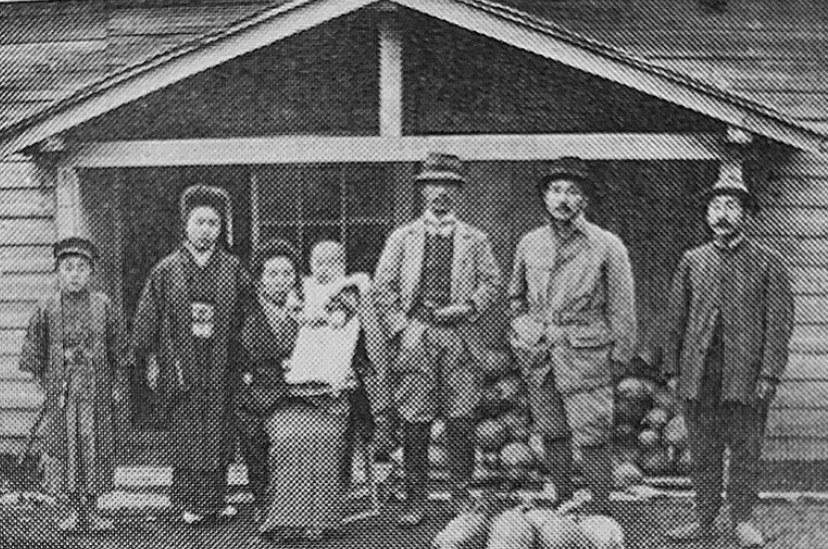
6. Personal Life and Relationships
Arishima Takeo's personal life was marked by both familial bonds and a final, tragic romantic involvement.
6.1. Marriage and Family
In 1909, Arishima married Yasuko Kamio, the second daughter of Major General Kamio Mitsuomi. Their first son, Yukimitsu, was born in Sapporo in 1911 and later became the internationally renowned film and stage actor, Masayuki Mori. In 1913, while teaching in Sapporo, Arishima built a Western-style residence in Kita-ku, near Hokkaido University, intending to settle there permanently. However, the following year, he had to leave Sapporo due to his wife's illness. Tragically, Yasuko died in 1916 at the age of 27 from tuberculosis in Hiratsuka, leaving Arishima with three children.
His other children included Toshiyuki, a translator who was reportedly engaged to Ishii Yoshiko but died young from tuberculosis during World War II, and Gyozō, who inherited the Kamio family name and became a baron. Arishima's family connections extended further: his sister Shima married Takagi Kōkan, the eldest son of Takagi Kanehiro, who founded the Jikei University School of Medicine. His sister Ai married Yamamoto Naoyoshi, the owner of the former Mikasa Hotel, and their grandson is the conductor and composer Yamamoto Naozumi.
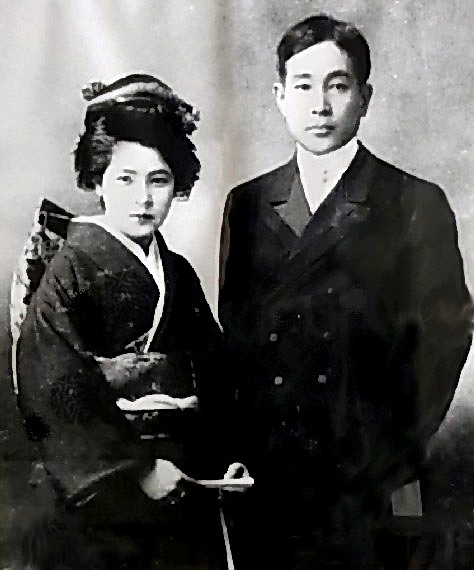
6.2. Relationship with Akiko Hatano
In 1923, Arishima, who had remained single since his wife's death, met Akiko Hatano. Hatano was a married editor working for Fujin Kōron, a prominent women's magazine. Their relationship quickly developed into an extramarital affair. When Hatano's husband, Harufusa, discovered the affair, he began to threaten them, causing immense distress to both Arishima and Hatano.
7. Death
The culmination of Arishima's personal struggles and the societal pressures he faced led to a tragic end.
7.1. Suicide
On June 9, 1923, Arishima Takeo and Akiko Hatano committed suicide by hanging themselves in a secluded villa known as Jogetsusō (浄月荘JōgetsusōJapanese) in Karuizawa, Nagano Prefecture. This act, a double suicide, became a widely publicized scandal in Japan.
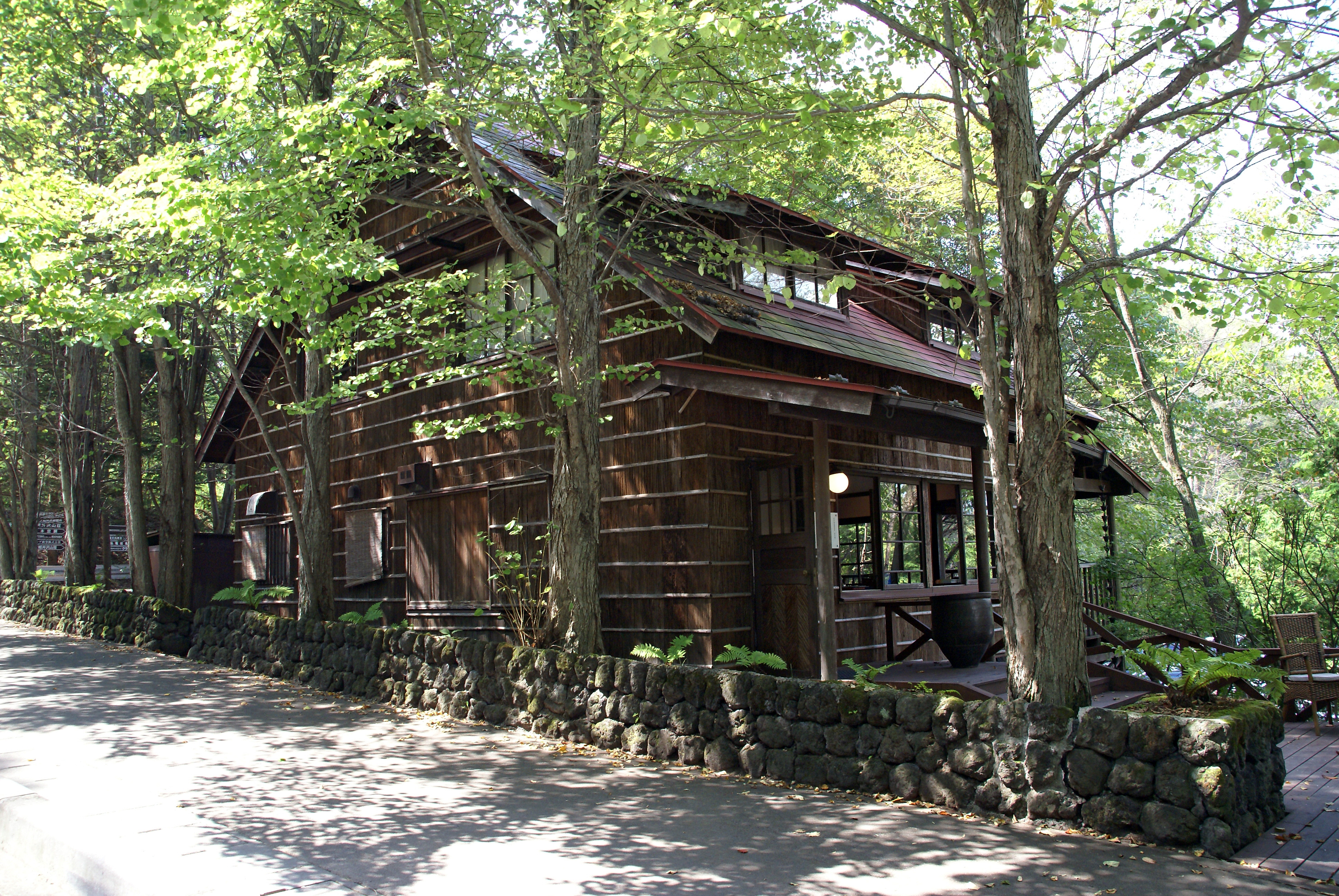
7.2. Discovery and Aftermath
Due to the isolated location of the villa, their bodies were not discovered for over a month. On July 7, the villa's manager found them. The bodies were severely decomposed due to the rainy season, but their identities were confirmed largely by the suicide notes left behind. One of the multiple notes Arishima left stated, "I had not thought until this moment that death could be so powerless before love." In July 2009, three letters exchanged between Arishima and Hatano from about half a year before their deaths were publicly exhibited at the Hokkaido Museum of Literature in Sapporo.
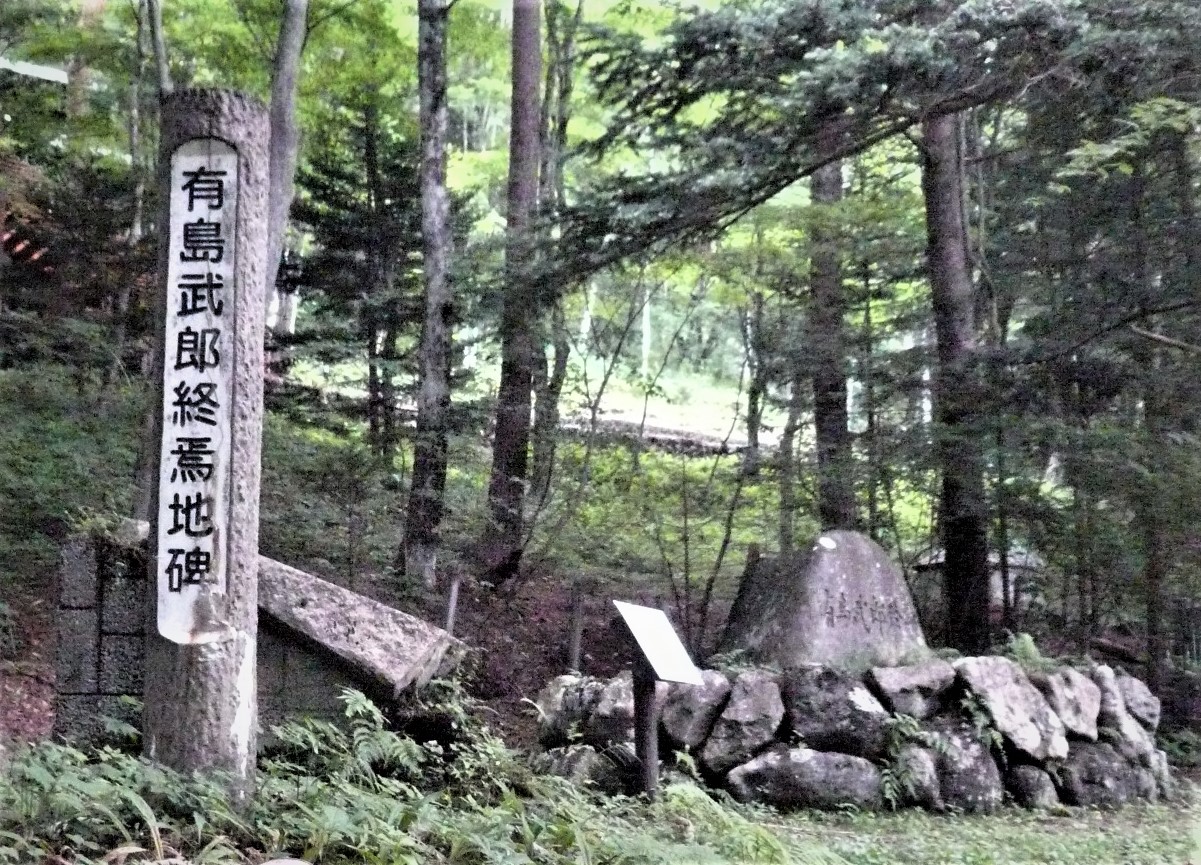
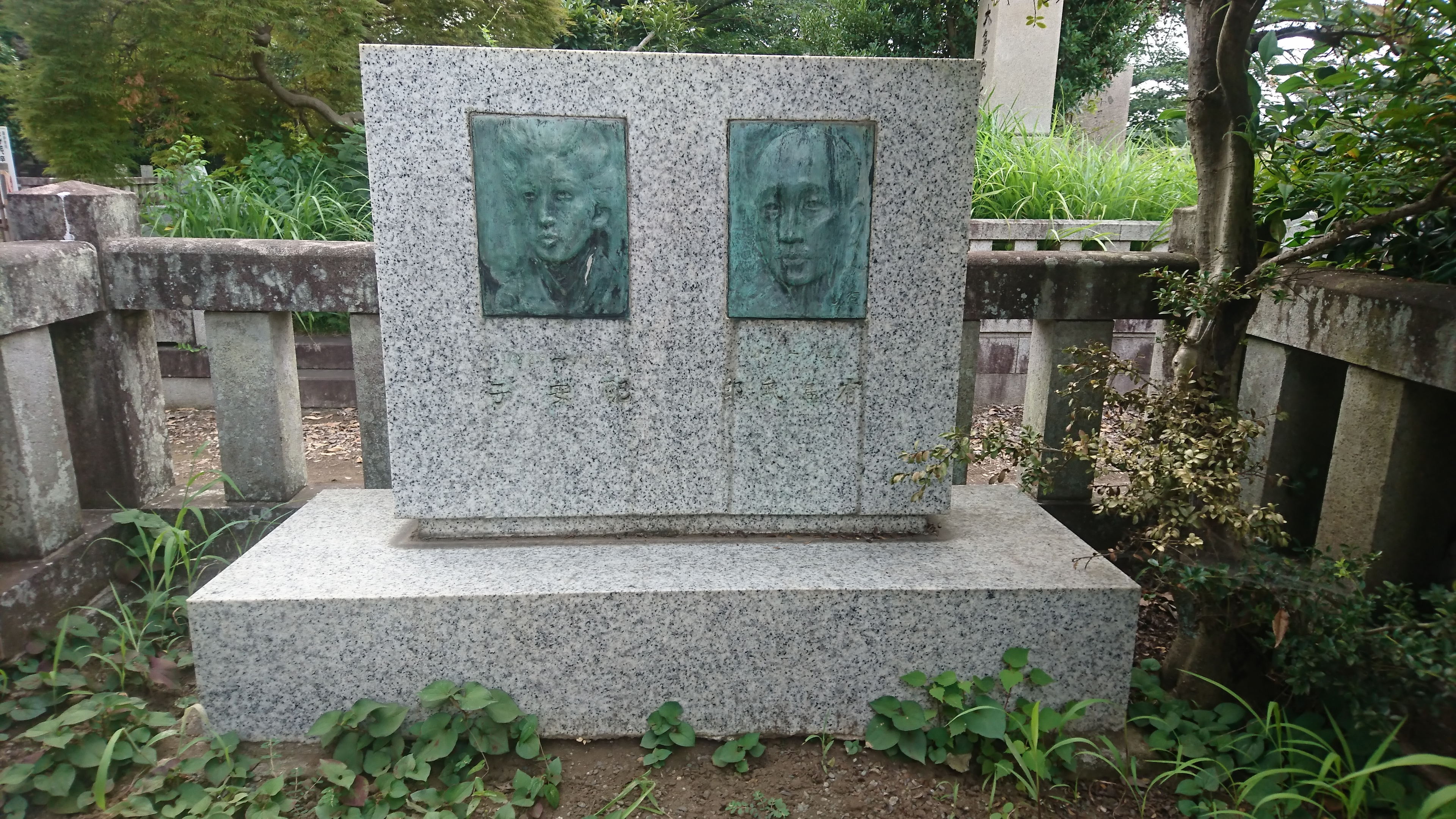
Arishima's grave is located at Tama Cemetery in Tokyo, where his tombstone features reliefs of his and Yasuko's faces.
His mentor, Uchimura Kanzō, reportedly declared that he would sever ties with any of his acquaintances who praised Arishima's actions. Arishima's farewell poems were later assessed by Karaki Junzō in his 1950 work About Suicide as being "no more than girlish sentiment."
8. Legacy and Evaluation
Takeo Arishima's impact extends beyond his literary works, encompassing his philosophical contributions and the enduring assessment of his life and ideas.
8.1. Diaries
After his death, Arishima became widely recognized for his extensive diaries, which comprise more than twenty volumes. These diaries offer an intimate and detailed record of his life, thoughts, fears, and hopes, providing invaluable insights into his intellectual development and personal struggles. They are considered significant not only for their literary merit but also for their historical value as a window into the intellectual climate of early 20th-century Japan.
8.2. Contemporary and Later Assessments
Arishima's contemporaries regarded him not only as a novelist but also as a profound philosopher and social critic. His writings were characterized by their critical stance towards Christianity and a strong influence from socialism. His style was emotionally intense and deeply humanistic, drawing ideas from the Bible, the works of Leo Tolstoy, and anarchic socialism. While his style was critically acclaimed, the challenging themes and characters in his works did not appeal to many contemporary Japanese readers. Despite this, his philosophical and critical contributions continue to be acknowledged in later literary history.
8.3. Criticism and Controversies
Arishima's works, while praised for their style, sometimes faced criticism for their themes and characters, which were not always popular with his contemporary audience. His decision to commit suicide with Akiko Hatano sparked considerable controversy and condemnation, notably from his former mentor, Uchimura Kanzō. The act also generated public debate about morality and personal freedom in Japanese society.
9. Impact
Takeo Arishima's literature and thought left a lasting influence on subsequent generations of writers and intellectual movements, both within Japan and internationally.
9.1. Influence on Literature and Thought
Arishima's distinctive literary style, his exploration of humanistic and social themes, and his philosophical ideas have significantly impacted later writers and intellectual movements in Japan. His works continue to be studied for their psychological depth and their critique of societal norms. His influence also extended beyond Japan; he gained considerable recognition in China due to the introduction of his works by the renowned writer Lu Xun, and his writings are still widely read and included in textbooks there.
10. Commemoration and Memorials
Several memorials and facilities have been established to honor Takeo Arishima's legacy and preserve his contributions.
- Arishima Memorial Museum:** Located in Niseko, Hokkaido, this museum preserves documents and materials related to the tenant farm in Hokkaido that Arishima famously renounced.
- Arishima Takeo Former Residence:** His Western-style house, originally built in Kita-ku, Sapporo, has been relocated and preserved at the Sapporo Art Park in Minami-ku, Sapporo. It features exhibits on Arishima's life.
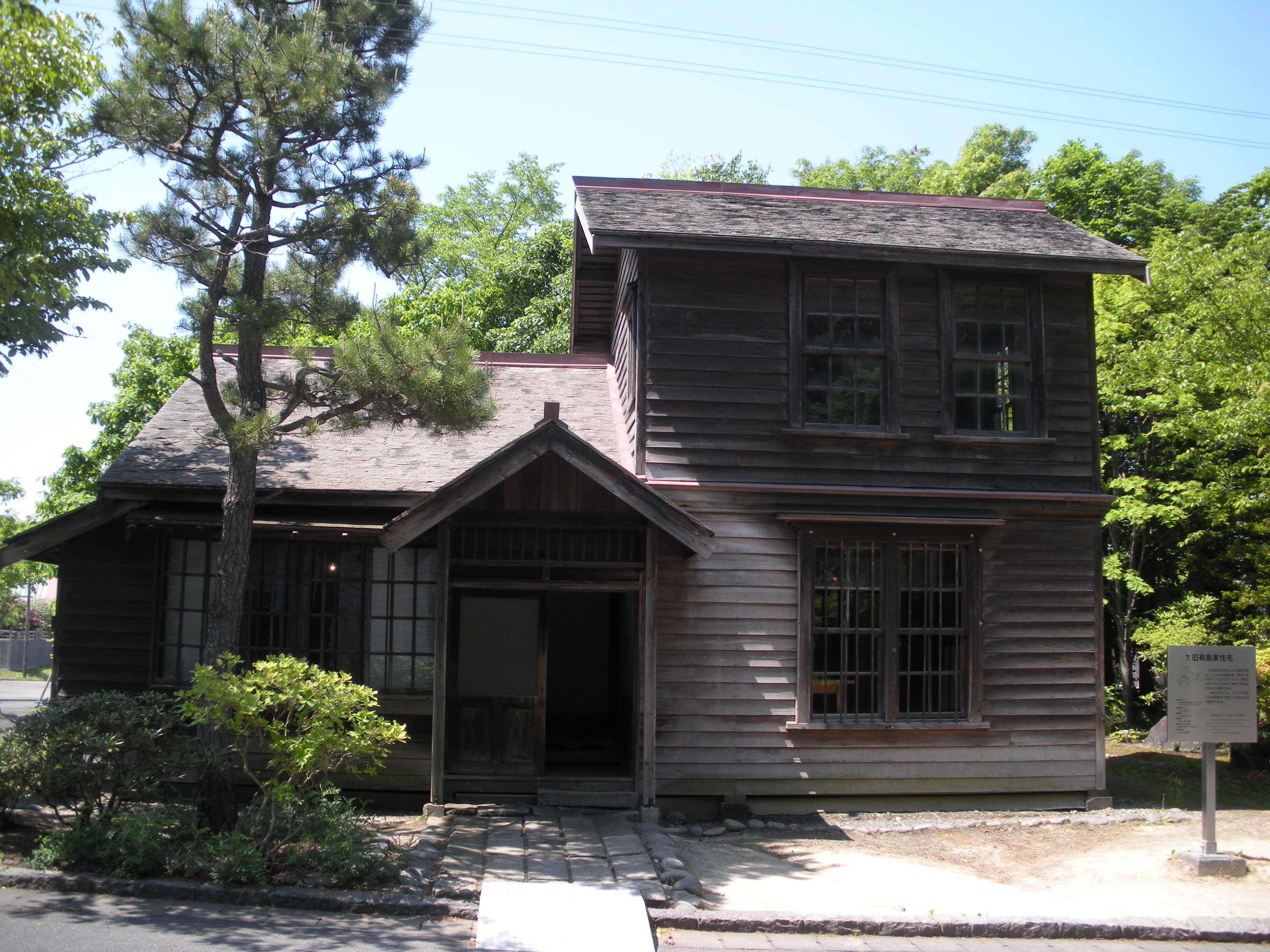
Additionally, his former residence in Shiroishi-ku, Sapporo, has been relocated and preserved at the Hokkaido Pioneer Village in Atsubetsu-ku, Sapporo. The site of his former residence in Shiroishi-ku also features remains and a monument.
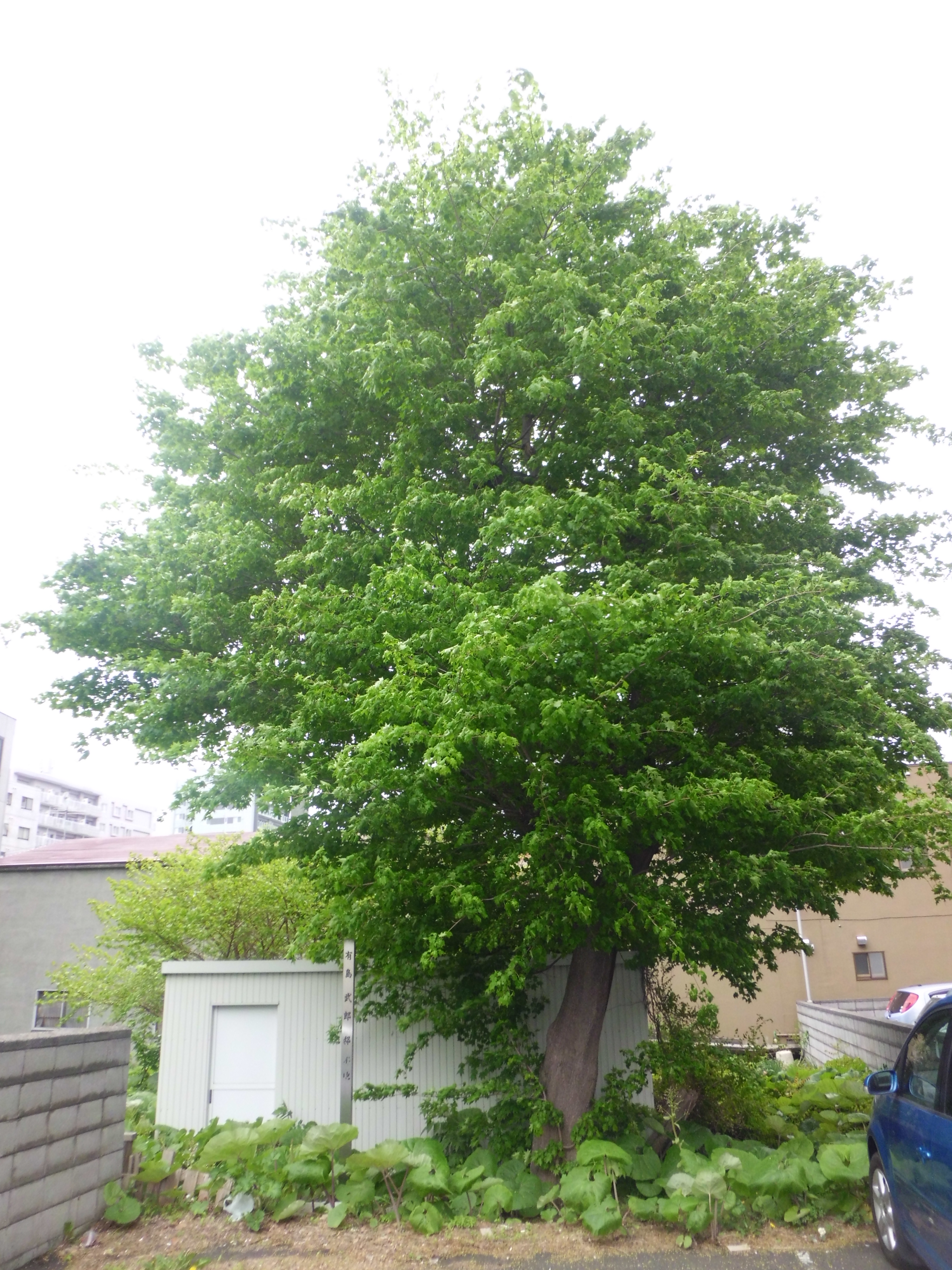
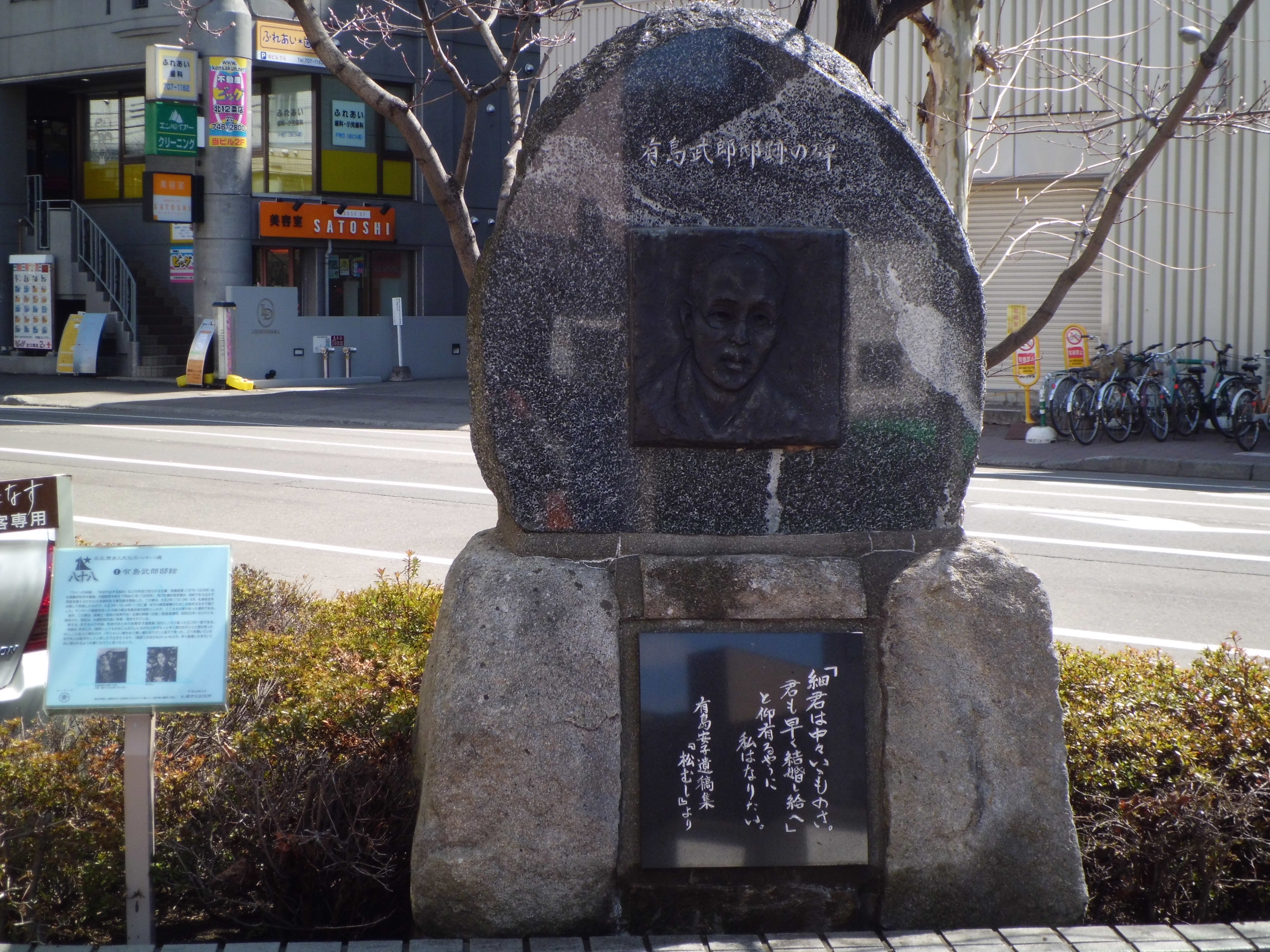
- Arishima Youth Literature Prize:** The Hokkaido Shimbun newspaper sponsors this literary award to encourage young writers, commemorating Arishima's deep connection to Hokkaido.
11. Related Figures and Topics
- Kokichi Morimoto
- Morito Tatsuo
- Tanikawa Tetsuzō
- Kagawa Toyohiko
- Kida Kinjirō
- Ōsugi Sakae
- Yamada Akio
- Nakamura Mitsuharu
- List of suicides in Japan